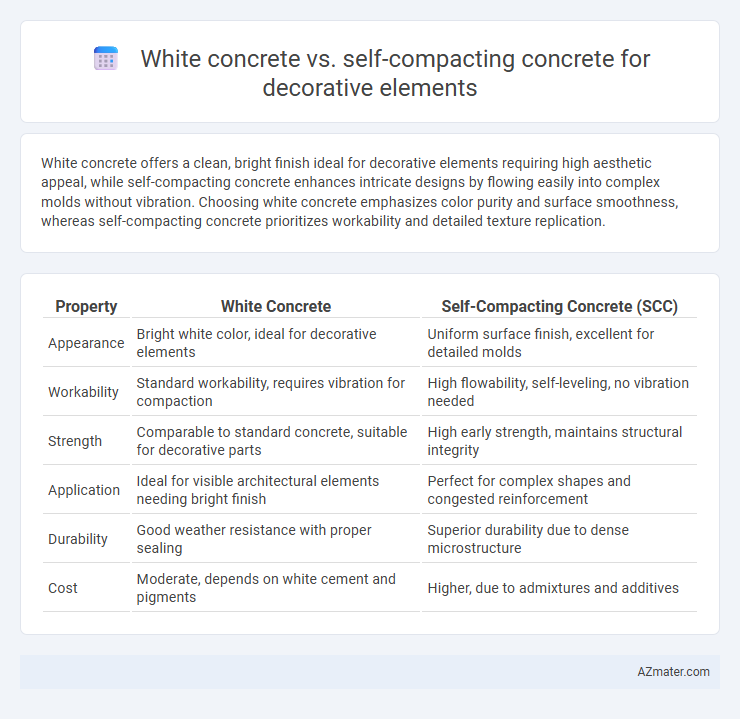White concrete offers a clean, bright finish ideal for decorative elements requiring high aesthetic appeal, while self-compacting concrete enhances intricate designs by flowing easily into complex molds without vibration. Choosing white concrete emphasizes color purity and surface smoothness, whereas self-compacting concrete prioritizes workability and detailed texture replication.
Table of Comparison
| Property | White Concrete | Self-Compacting Concrete (SCC) |
|---|---|---|
| Appearance | Bright white color, ideal for decorative elements | Uniform surface finish, excellent for detailed molds |
| Workability | Standard workability, requires vibration for compaction | High flowability, self-leveling, no vibration needed |
| Strength | Comparable to standard concrete, suitable for decorative parts | High early strength, maintains structural integrity |
| Application | Ideal for visible architectural elements needing bright finish | Perfect for complex shapes and congested reinforcement |
| Durability | Good weather resistance with proper sealing | Superior durability due to dense microstructure |
| Cost | Moderate, depends on white cement and pigments | Higher, due to admixtures and additives |
Introduction to Decorative Concrete Elements
White concrete offers a bright, clean base ideal for decorative elements requiring high aesthetic appeal and color uniformity, often used in architectural facades and sculptural forms. Self-compacting concrete (SCC) enhances decorative craftsmanship by flowing easily into intricate molds and tight spaces without vibration, ensuring smooth surfaces and detailed textures. Both materials provide unique advantages for decorative applications, with white concrete emphasizing color clarity and SCC optimizing precision and surface finish.
Overview of White Concrete
White concrete offers a high aesthetic appeal due to its bright, uniform color achieved by using white cement and light-colored aggregates, making it ideal for decorative elements. Its enhanced visual quality and durability allow for detailed architectural designs and smooth finishes without the typical gray tint. White concrete's reflective properties also help in reducing heat absorption, making it a preferred choice for visually striking and functional decorative applications.
Key Features of Self-Compacting Concrete
Self-compacting concrete (SCC) offers superior flowability and high deformability without segregation, enabling intricate decorative elements to be cast with minimal effort. SCC's key features include high filling ability, passing ability through dense reinforcement, and uniform surface finish, which significantly reduce labor costs and enhance aesthetic precision compared to traditional white concrete. Its optimized mix design ensures consistent strength and durability, making it ideal for complex architectural details where surface quality and detail retention are critical.
Aesthetic Appeal: Color and Texture Comparison
White concrete offers a bright, uniform color that enhances the visibility of intricate designs and provides a clean, contemporary aesthetic for decorative elements. Self-compacting concrete (SCC) achieves a smooth, dense texture without surface voids, ensuring sharp, detailed patterns and a flawless finish that elevates visual appeal. The combination of white concrete's vibrant hue with SCC's superior surface quality results in decorative elements with exceptional color brilliance and refined texture.
Workability and Placement Techniques
White concrete offers excellent visual appeal for decorative elements but requires skilled labor for proper workability and careful vibration to avoid discoloration. Self-compacting concrete (SCC) provides superior flowability and ease of placement, eliminating the need for vibration and ensuring uniform texture in intricate molds. The choice between white concrete and SCC depends on the balance between aesthetic requirements and efficiency in casting complex decorative shapes.
Surface Finish and Detailing Capabilities
White concrete offers a smooth, bright surface finish ideal for highly visible decorative elements, enhancing aesthetic appeal through its clean and consistent color. Self-compacting concrete excels in detailed molds and intricate designs due to its high flowability, ensuring superior surface uniformity and minimizing voids or honeycombing. Combining white concrete with self-compacting properties provides optimal finish quality and precision for complex decorative elements.
Strength and Durability Factors
White concrete offers high compressive strength and superior durability due to its carefully selected white cement and aggregates, making it ideal for aesthetically demanding decorative elements exposed to weathering. Self-compacting concrete (SCC) provides excellent uniformity and reduces voids, enhancing durability and strength while ensuring intricate design details are maintained without vibration. Both materials exhibit strong resistance to cracking and environmental wear, but SCC's flowability improves reinforcement encapsulation, potentially increasing long-term structural integrity in decorative applications.
Cost Considerations: Material and Labor
White concrete typically incurs higher material costs due to the specialized white cement and aggregates required, impacting the overall budget for decorative elements. Self-compacting concrete reduces labor expenses by eliminating the need for extensive vibration and finishing, leading to faster placement and less skilled labor. When balancing cost considerations for decorative elements, white concrete demands greater investment in materials, while self-compacting concrete offers savings primarily through reduced labor and improved productivity.
Sustainability and Environmental Impact
White concrete uses titanium dioxide to enhance durability and reflectivity, reducing urban heat island effects and lowering cooling energy demands. Self-compacting concrete minimizes waste through superior flowability, enabling precise placement and reduced material usage, which cuts carbon emissions from production. Both contribute to sustainable construction by improving resource efficiency and lowering environmental footprints in decorative applications.
Best Applications for Decorative Projects
White concrete offers a bright, uniform base ideal for decorative elements requiring high aesthetic appeal, such as facade panels, sculptures, and architectural finishes. Self-compacting concrete excels in complex molds and intricate designs due to its superior flowability and ability to fill forms without vibration, making it perfect for detailed decorative features and dense reinforcement areas. Choosing between white concrete and self-compacting concrete depends on whether the project prioritizes surface color and finish or intricate shape and ease of casting in decorative applications.

Infographic: White concrete vs Self-compacting concrete for Decorative element
 azmater.com
azmater.com